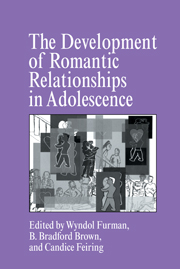Book contents
- Frontmatter
- Contents
- Contributors
- Foreword
- Acknowledgments
- 1 Missing the Love Boat: Why Researchers Have Shied Away from Adolescent Romance
- Part I Processes in Romantic Relationships
- Part II Individual Differences in Romantic Relationships
- 6 Capacity for Intimate Relationships: A Developmental Construction
- 7 Rejection Sensitivity and Adolescent Romantic Relationships
- 8 Sex, Dating, Passionate Friendships, and Romance: Intimate Peer Relations Among Lesbian, Gay, and Bisexual Adolescents
- 9 Gender Identity and the Development of Romantic Relationships in Adolescence
- Part III The Social Context of Romantic Relationships
- Part IV Conclusion
- Author Index
- Subject Index
7 - Rejection Sensitivity and Adolescent Romantic Relationships
Published online by Cambridge University Press: 05 October 2014
- Frontmatter
- Contents
- Contributors
- Foreword
- Acknowledgments
- 1 Missing the Love Boat: Why Researchers Have Shied Away from Adolescent Romance
- Part I Processes in Romantic Relationships
- Part II Individual Differences in Romantic Relationships
- 6 Capacity for Intimate Relationships: A Developmental Construction
- 7 Rejection Sensitivity and Adolescent Romantic Relationships
- 8 Sex, Dating, Passionate Friendships, and Romance: Intimate Peer Relations Among Lesbian, Gay, and Bisexual Adolescents
- 9 Gender Identity and the Development of Romantic Relationships in Adolescence
- Part III The Social Context of Romantic Relationships
- Part IV Conclusion
- Author Index
- Subject Index
Summary
A key function of romantic relationships is to make people feel accepted and loved, thus promoting well-being. Yet, many relationships do not serve this function. Adults give relationship difficulties as the most common reason for seeking therapy (Veroff, Kulka, & Douvan, 1981). People in conflicted marriages are often depressed (Coyne, Downey, & Boergers, 1994), and intimate violence is a leading cause of injuries to both adult and adolescent women (Browne, 1993; Centers for Disease Control, 1990). Because troubled romantic relationships are both pervasive and costly, there is considerable interest in understanding how relationships are undermined.
Initially, research on the causes of troubled intimate relationships focused on married couples. It is now clear that the destructive interactional patterns that undermine marriages are evident in adult dating relationships and may be present in adolescent relationships. Intimate violence is a case in point. Minor dating violence precedes serious marital violence in 25% to 50% of cases (Gayford, 1975; O'Leary & Arias, 1988; Roscoe & Benaske, 1985). The level of violence in adult dating relationships is similar to that found in marital relationships (Sugarman & Hotaling, 1989). Reported rates of dating violence in high school students range from 9% to 45% (Bergman, 1992; Downey, Lebolt, & O'Shea-Lauber, 1995; Henton, Cate, Koval, Lloyd, & Christopher, 1983; Molidor, 1993; O'Keefe, Brockopp, & Chew, 1986; Roscoe & Callahan, 1985; Roscoe, & Kelsey, 1986).
- Type
- Chapter
- Information
- The Development of Romantic Relationships in Adolescence , pp. 148 - 174Publisher: Cambridge University PressPrint publication year: 1999
- 94
- Cited by

